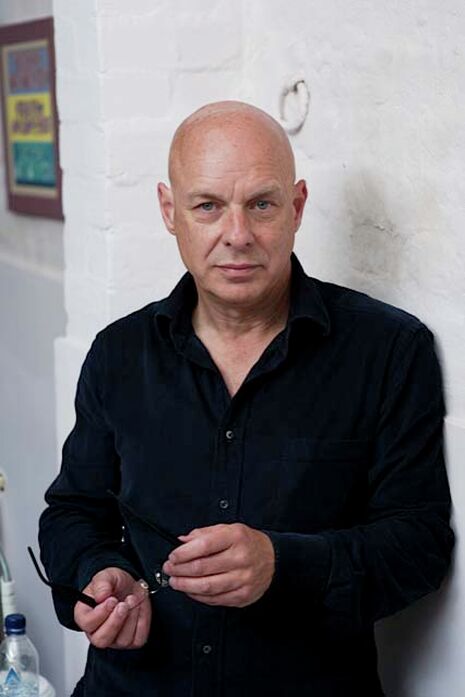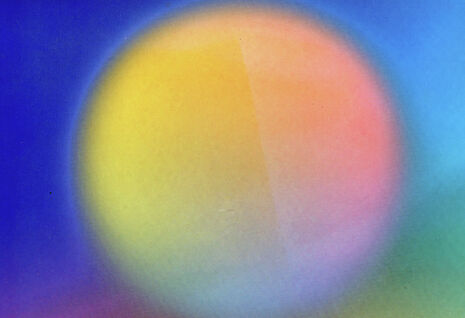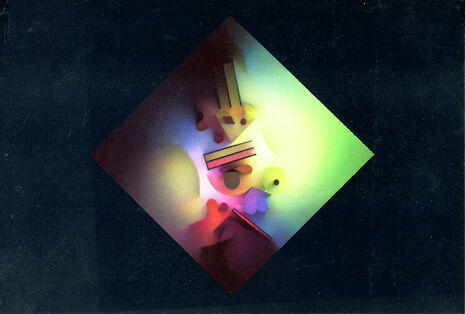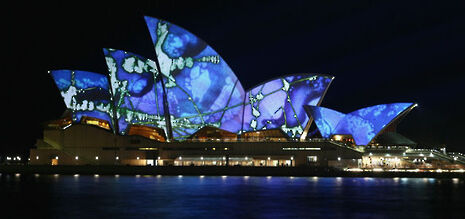Enotes
Madeleine Morley and Louise Benson spend an afternoon discussing lightbulbs, art school and airports with Brian Eno

When we arrive at Brian Eno’s Notting Hill studio, he is happily painting light bulbs. People know Brian Eno best as founder member of Roxy Music, as writer, electronic musician and singer, collaborating with, amongst others, David Bowie, Talking Heads and Devo, and most famously the producer of U2 and Coldplay. We meet him now as much more than a musician; Eno is a visual artist, scientist, philosopher, and teacher. The sheer volume of his creative output over the last forty years is immense, but we are not meeting him to discuss the latest production in such a prodigious list. Instead, what unfurls is a long, meandering afternoon spent exploring the process behind any number of his future opuses, real or imagined. And the lightbulbs.
Brian is painting lightbulbs because he doesn’t like the harsh light that the regular ones produce. The layers of paint (glass paint, not regular, so as not to crack when heated) marble together, forming curiously lovely objects of the bulbs. He screws one into place in his studio, demonstrating the softly warped colours it now emits, and whose warm, brownish tinge illuminates the room from then on.
We ask Brian – who himself has consistently used his music and art to teach others – about those that taught him. “An important teacher for me was a self-taught woman named Joan Harvey, my then girlfriend’s mother,” says Brian, inserting various CDs into the simple, worn, portable players suspended mysteriously from the lofty ceiling at ear level. “Joan was fascinated by science, very clever and free thinking. I spent the whole summer in the village of Harston in Cambridgshire, living in a double decker bus on her land. I was very young, 17 or so. One day she said to me, ‘Brian, I like you, but I just can’t understand why someone with your kind of brain wants to waste it being an artist.’ That was possibly one of the most important things that a person has ever said to me. It started me on a process of not only be an artist but thinking about why people are artists, why we want art, and why we care about it.’”
He presses play and from all sides of the room emerges subtle, translucent noise, filling the studio with deeply still yet somehow active sound. On the wall, a small-scale version of Brian’s project 77 Million Paintings, which he has displayed in places ranging from the arch of a historic roman corridor to the Sydney Opera House, is throbbing softly. Its shifting, kaleidoscopic shapes appear to react with – or rather, to create – the sounds trickling from the walls; the picture as music, the sound a painting as they merge. His studio expands with possibilities and becomes a theme park, Brian a cross between George Melies and the most astute of Willy Wonka figures.

We move into his recording studio and he tells us about his time at the Colchester Institute, where he began to seek answers to some of the questions raised by Joan. The teachers at the Colchester Institute in Essex had mixed reactions to Brian’s work, unable to easily categorise it. He recalls how his work divided the teachers at the school, and details how this pushed him to consider the nature and function of art institutions, one of his enduring interests.
“There are two ways that art schools can work. The first is to ask, ‘Do we decide on an area and teach it and get really good at teaching it?’ This is quite conservative in a way, because it decides that whatever you plan to do in the rest of your life, it’ll be good if you master life drawing and colour theory. Another way of running an art school is to say, ‘We don’t know what art is going to be in the future, in fact, these students probably have a better idea than we do, so we’ll let them mutate the course to their own satisfaction.’ Good teachers realise that the students are the antenna; they are sensing things that the teachers don’t yet sense.”
“For that same reason, when you are at art school, the other students are your learning environment. I think that this is something that nearly all other educational systems could learn from. It is unofficially like that everywhere – it is the people you’re at college with that you spend the most time with, talking in depth to. This should be encouraged more.”

Playing with different buttons and filters on his computer to tweak one of his new projects (a music piece commissioned for an Italian palace) as if performing complex surgery, Brian tells us the story of another important teacher, his art professor, Tom Phillips, who taught him during his time at the Colchester Institute. “Tom came up to a painting I’d spent a lot of time on and was rather proud of. He said ‘It’s a bit slight, isn’t it?’ That was quite irritating, but in a good way. After this I started thinking: why isn’t this a good painting? What is wrong with it? What do I want to do with this? What am I painting anyway? I started thinking about a lot more fundamental questions rather than ‘is this the right kind of red or not?’ I’ve always thought that a strong opinion, whether you agree with it or not, is worth more than a weak opinion. The good teachers that I’ve had are all people whose opinions alternately both fascinate and irritate me.”
Brian opens up a drum sample to show us how subtle electronic changes can produce staggeringly different effects. He puts the speakers up to their loudest, the pulsating rhythm shaking the piled books on the shelves above us. Books on John Cage, John Peel, John Cale, the electric music of Miles Davies, one titled the Physics of Music, and a book on No Wave by Sonic Youth’s Thurston Moore nearly crash down on our heads (“Those are just the music books, the library in the other room was too full”) Brian continues to contemplate the best friends and teachers who helped to shape his philosophy and interest in the role of places and spaces forming a function for music – and art – to fulfill.
“I started asking myself these questions about what does art exist for, is it just some form of masturbation or a luxury add on to life, or is it crucial in some way? I have a broad definition of art, to include everything from crochet to Cezanne, anything that people do for stylistic reasons. Art is everything you don’t have to do. You have to wear clothes, but you don’t have to stylise them. You could just wear sacks or animal pelts. I started thinking about why we make those decisions. It started me thinking about the role of music in public places.” Brian’s black cat, Angel, with white slipper paws slinks into the room and sits beside Brian’s stained glass window that he keeps propped up against a cupboard, transforming the space from a whitewashed studio room to somewhere with a hint of mysterious, shimmering history.
Brian talks about the inspiration for his Ambient 1: Music for Airports, released in 1978, which effectively invented ambient music as a pop genre. “I was in an airport in Cologne, a newly built, very beautiful modern airport, lots of glass, sun streaming in on a Sunday morning, not very many other people there. It was really carefully designed down to the details, except blaring across the PA system was the crappiest piece of music, some German pop or something, and I thought, this is completely insane! I went into a sort of thought experiment of trying to imagine what you would want from music for this space. It should be like sitting by a river, where things are always changing in detail but at the larger scale they’re not changing. It’s the level of consistency versus surprise that interested me. I felt that most of the music you ever heard at airports was trying to conceal the fact that you were slightly nervous. I wanted to change your state of mind so that you sort of settled down and thought, okay, I’ll just be for a little while, I’ll stop worrying and just be.”
From the other room, the 77 Million Paintings gently twists into the shape of a river. Brian squints, seeing something else entirely: “It’s the pizza again!” he shouts to a friend in the upstairs room. With all the thousands of combinations his artwork can mutate into, a sequence never repeats itself twice.
Brian shows us how he makes film music, transferring a distorted drum sound – “I’ll call it “Dark Drums Maddy and Louise”– into his iTunes, and turning it into soundtrack music. ‘I’d be sitting in the studio in the late 70s working on something, like now, and at the end of the day I’d say, now I’m going to do the film mix, and I would just slow the tape down by half speed. This has two effects, first it makes everything softer, deeper, but it also means that half as many events happen in the same amount of time. Immediately the music opens out, there is twice as much space as there was before. It’s what people started doing later on and they called it ‘remixing.’ The shocking thing to me was that I’d often prefer those things that I did in twenty minutes, over the version I’d been working on all day. So I thought, I want to compose film soundtracks, I’ll release an album called Music for Films and then people will think that I have been already producing music for film soundtracks.”

For a while, we are collaborating with Brian Eno, a very interesting place to be. He loves to collaborate with others.
“It’s a very good way of getting to know someone. They say that you should never marry someone until you’ve gone camping with them, how you really don’t know someone until you’ve seen them in a stressful situation, and I think it’s true when you’re working with someone, it’s sort of when you’re tired and things haven’t been going that well that day, if the relationship holds up, then it’s pretty strong. Sometimes you meet people that you get on terribly well with, but there is no working relationship, because you agree too much with each other.”
We’ve been recording the interview on an iPhone and suddenly get a call, momentarily disconcerting him. It seems a good time to ask him about the iPad, iPhone, Apple era. “I think what interests me about apps and all other new technologies is that everything invented is invented for a historical reason. People invented multitrack recording, not so Phil Spector could come along and do fabulous things, but simply so that recording engineers could have the voice and the band on separate tracks so that they could balance after the event. Multitrack recording started for the most mundane reason of all, simply so we don’t have to pay the musicians so much. But what people discovered was that multitrack recording enabled you to stop thinking about music as performance, and start thinking about it as painting. It changed music completely from a medium that is trapped in time, to a medium that is free of time, which exists in space now. It’s become what I call a plastic medium.”“I can guarantee that all the interesting things that happen with apps will be similar to that, they will be nothing to do with video games. There are three or four that are interesting, one which is a sort of oriental music making machine, and it’s absolutely beautiful and quite mysterious: that’s a little seed of the future there. Most of the apps I see, they’re historical – like what’s that famous one, fucking angry birds or something? – It’s fine, but it’s nothing new, that’s not the future, that’s the past. Apps should be the future.”
Having taken on so many different roles, app maker, visual artist, lecturer, we wonder whether he minds being labeled in people’s minds as a musician alone. “People think, particularly in England, that I have a short attention span, they’re asking ‘why don’t you settle down and do one thing over and over and over again?’ It’s something every creative person understands, and all critics find suspicious. Most critics and most people who write about art, are still stuck with a romantic notion of what an artist is. A lot of artists play to that, because they think it’s cool and they think it’s good publicity. The romantic notion of an artist is someone who is not happy, deeply disturbed at some level, unintellectual. Intellectual artists are always suspect. The romantic idea is that passion rules, passion and intellect don’t sit together well. This is why Tracey Emin is so well loved, I believe, because she sits perfectly in the container that says ‘fascinating female artist.’”
Outside it is dark, though the light in Brian’s room never changes – due, perhaps, to the marbled paint on those lightbulbs, or the effect of the shifting stream of music echoing from the hanging boomboxes. Here, time runs slow, as with Brian’s collaborative project The Clock of the Long Now, which strikes every 1,000 years. Brian’s new ‘Dark Drum’ mix sounds like the strange journey we’ve been on around his studio, from one disorienting world to another. We ask how he chooses from the thousands of snippets and musical sketches he creates, just like the one he has made with us, and how he knows when a track is finished. “I feel something has worked when I get a feeling about a specific time and a place, or a kind of weather or something. I don’t want to just hear music, I’m not actually interested in music, more what it can generate and make you feel. I want to be able to think, ‘Oh yes, I can feel that place, it’s quite chilly.’”
After five hours of Brian composing, answering, thinking and remembering, we emerge from his studio somewhat dazed to encounter the outside world once more. It’s safe to say that Eno has taught us something.
 Features / How sweet is the en-suite deal?13 January 2026
Features / How sweet is the en-suite deal?13 January 2026 Arts / Fact-checking R.F. Kuang’s Katabasis13 January 2026
Arts / Fact-checking R.F. Kuang’s Katabasis13 January 2026 News / SU sabbs join calls condemning Israeli attack on West Bank university13 January 2026
News / SU sabbs join calls condemning Israeli attack on West Bank university13 January 2026 Comment / Will the town and gown divide ever truly be resolved?12 January 2026
Comment / Will the town and gown divide ever truly be resolved?12 January 2026 News / 20 vet organisations sign letter backing Cam vet course13 January 2026
News / 20 vet organisations sign letter backing Cam vet course13 January 2026









